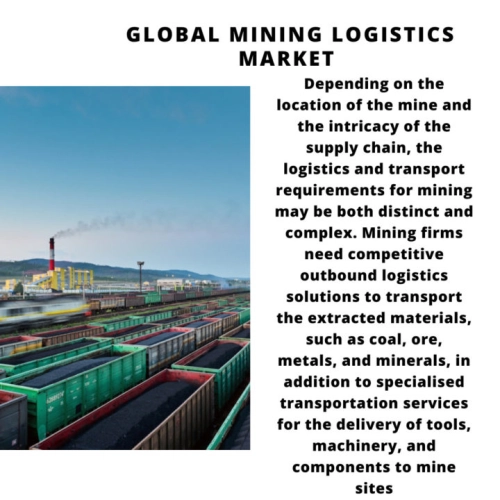
- Get in Touch with Us

Last Updated: Apr 25, 2025 | Study Period: 2024-2030
Depending on the location of the mine and the intricacy of the supply chain, the logistics and transport requirements for mining may be both distinct and complex.
Mining firms need competitive outbound logistics solutions to transport the extracted materials, such as coal, ore, metals, and minerals, in addition to specialised transportation services for the delivery of tools, machinery, and components to mine sites.
The vital link in the global mining supply chain is provided by multimodal logistics, which includes trucks, trains, and ships.

A competitive edge could be gained through careful planning and the use of efficient end-to-end logistics solutions, as well as time and money savings.
In order to ensure efficient material movement from mines, processing facilities, and stockpiles to trains, ports, ships, and ultimately the target markets, the mining industry needs complete logistical services and solutions.
To optimise production planning and supply chain efficiency, mining businesses seek out logistics solutions that are dependable, flexible, and affordable as well as provide enhanced transparency and coordination.
TheGlobal mining logistics marketaccounted for $XX Billion in 2023 and is anticipated to reach $XX Billion by 2030, registering a CAGR of XX% from 2024 to 2030.
At its open-pit mine, NLMK Group company Stoilensky Mining and Beneficiation Plant has implemented a new hauling system. The transporting distance for raw materials to the facilities for beneficiation has been shortened by 5 km thanks to this large-scale operation.
A significant turning point in Stoilensky's development is the implementation of the new logistics plan. With the help of this extensive project, we were able to decrease the price of transporting raw materials from the open-pit mine, set up the infrastructure needed for future increases in ore production, and increase overall efficiency at the businessâthe primary supplier of raw materials to NLMK.
| Sl no | Topic |
| 1 | Market Segmentation |
| 2 | Scope of the report |
| 3 | Abbreviations |
| 4 | Research Methodology |
| 5 | Executive Summary |
| 6 | Introduction |
| 7 | Insights from Industry stakeholders |
| 8 | Cost breakdown of Product by sub-components and average profit margin |
| 9 | Disruptive innovation in the Industry |
| 10 | Technology trends in the Industry |
| 11 | Consumer trends in the industry |
| 12 | Recent Production Milestones |
| 13 | Component Manufacturing in US, EU and China |
| 14 | COVID-19 impact on overall market |
| 15 | COVID-19 impact on Production of components |
| 16 | COVID-19 impact on Point of sale |
| 17 | Market Segmentation, Dynamics and Forecast by Geography, 2024-2030 |
| 18 | Market Segmentation, Dynamics and Forecast by Product Type, 2024-2030 |
| 19 | Market Segmentation, Dynamics and Forecast by Application, 2024-2030 |
| 20 | Market Segmentation, Dynamics and Forecast by End use, 2024-2030 |
| 21 | Product installation rate by OEM, 2023 |
| 22 | Incline/Decline in Average B-2-B selling price in past 5 years |
| 23 | Competition from substitute products |
| 24 | Gross margin and average profitability of suppliers |
| 25 | New product development in past 12 months |
| 26 | M&A in past 12 months |
| 27 | Growth strategy of leading players |
| 28 | Market share of vendors, 2023 |
| 29 | Company Profiles |
| 30 | Unmet needs and opportunity for new suppliers |
| 31 | Conclusion |
| 32 | Appendix |